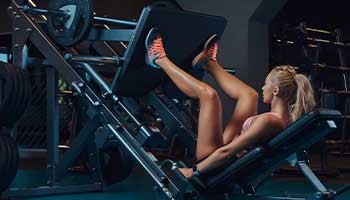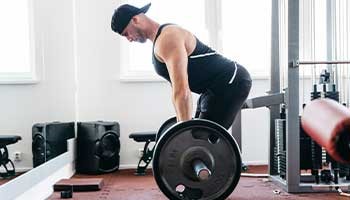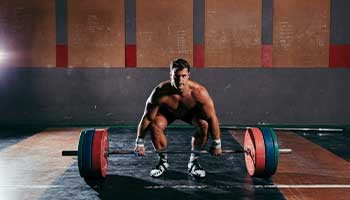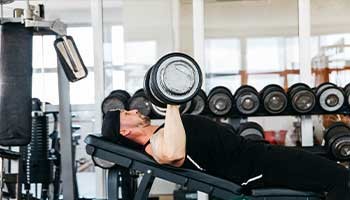Leg Press vs. Squats: The Pros and Cons

The golden rule of fitness is to always remember “Never skip a leg day.” Lower body workouts are essential to maintain a strong foundation and good body symmetry.
Both, Legs presses and squats have their pros & cons but they are excellent workout programs for strength training and building muscle mass. So, how do you choose? Well, we have compiled the ultimate guide for you to meticulously weigh the benefits against each other to choose the workout that gets the most out of you.
- Leg Press
- Squats
- Leg presses vs. squats: Difference
- Leg presses vs. squats: Pros & Cons
- Safety Tips
- Leg presses vs. squats: The winner
- Conclusion
Leg Press
A leg press machine is designed to specifically exercise the quads with a secondary focus on the glutes and hamstrings. It is similar to a squat, but in a leg press the weight shifts from the back to the legs which is a better option for people with lower back issues or those dealing with injuries.
A systematic review was conducted to analyse muscle activation when performing leg press exercises and its variants and it was found that leg press exercises optimised training and rehabilitation programs. It can be used to target specific muscle groups and improve overall muscle function. (1)
Squat
Squats are a part of strength training exercises that help train the lower body muscles and develop core strength.
The primary muscles used during squats are the quads, adductor magnus (triangular muscle on the medial side of the thigh), and glutes.
Some variants of squats are:
- Barbell squats
- Back squat
- Front squat
- Hack squat
- Overhead squat
- Steinborn squat
A study found that squats can be used for rehabilitative activities as they help in achieving stability after an injury without excessive compression on the tibiofemoral joint (knee cap region) and anterior cruciate ligament (ligament in knees) (2)
Leg presses vs. squats: Difference
Technique & Form
- Leg Press: a leg press machine requires you to be in a seated position or lying down, this provides extra support and stability
- Squat: In a squat you stand and then lower your body, engaging several other muscle groups that require balance and coordination
Targeted Muscles
- Leg Press: The leg press workout regime focuses on the lower body muscle groups and more specifically your quads with the involvement of the gluteus maximus and hamstrings.
- Squat: while quads are a common target for both, with a squat you tend to engage more with auxiliary muscles such as the hamstrings, glutes, and core which are secondary in a leg press.
Mechanics
- Leg press: It requires a piece of equipment designed specifically with a fixed range of motions that helps with balance and control
- Squats: you can perform a squat anywhere and it only requires proper balance and control throughout the workout.
Real-life functional carryover
- Leg press: It may be exclusive to the workout regime and doesn’t have any functional carryover with very limited representation of everyday activities
- Squats: they are excellent functional carryovers to real-life moments such as running, walking, and jumping as they engage the core and stabilise the muscles.

Possible Injuries
- Leg press: if not performed correctly it can cause stress on the knees and lower back due to its fixed range of motion
- Squats: incorrect form can lead to injuries in the hips, spine, and knees.
Variations
- Leg press: can only be performed on a fixed foot placement and weight and has limited variation options
- Squats: has several variants, stances, weights and styles.
Leg presses vs. squats: Pros & Cons
Leg Press
Pros:
- Easy on the joints: A leg press workout is a machine-based exercise that lets you lift heavier weights without putting excessive strain on your joints.
- Works Quads: leg press is excellent to target the quads and extremely beneficial for athletes who want to improve their strength and endurance.
- Convenient: the leg press can be done in various settings that are convenient to you and can be easily accessed at gyms or even bought for homes.
Cons:
- Limited range of motions: the leg press machine is focused on the repetition of a singular style of motion which limits its ability to be effective for building overall strength and muscle in the legs.
- Machine-based: Leg press requires the use of a machine and may not be accessible to some or can be very limiting.
- Less core activation: leg press is not as focused on core activation as squats which can hinder the building of core muscles.
Squats
Pros:
- Full range of motion: squats involve a full body motion that can help target several muscle groups and help build better strength overall.
- Functional strength: squats can be useful for everyday activities such as running or jogging making it a functional strength workout.
- Core activation: squats are more focused on the activation of core muscles compared to leg press.
Cons:
- Joint stress: squats can be stressful on the joints, especially the knees and hips and can be challenging for individuals with injuries.
- Proper form needed: squats require proper form to be safe and effective or it can lead to injuries.
- Harder to perfect: unlike leg presses, squats can be a bit challenging for beginners and might be slightly more difficult to learn.
Safety Tips
It is important to remember that with both leg presses and squats, it is best to avoid overloading the weight.
It is not advisable to use a weight that you cannot control which can lead to knee injuries, back problems or other serious issues. Start with a weight that is comfortable for you to lift more than 3 times, then gradually build up on it.
It is recommended to have a spotter while doing squats to help you, and with leg presses remember to not lock your knees when you extend your legs.
Leg presses vs. squats: The winner
As much as we’d like to crown one of them as the winner, the truth is both are equally amazing and deserve to be the winners! Everybody is different and for some squats might be a better option and leg presses for others.
Squats may have the edge given their ability to be a full-body workout and their ability to improve your overall sports performance, but leg presses are also a great option for those suffering from back problems or injuries.
You can involve both of them in your exercise routine to have a variety on your leg day and schedule the workouts well to not overtrain your muscles.
Conclusion
Whether you are team squats or team leg press, both have excellent benefits and overall results.
If you do not want to pick a team you can easily do both with a proper training plan from your trainer or coach to reap benefits both ways and build better leg strength and endurance.
If you experience any injuries or pain while doing workouts, reach out to your healthcare provider for assistance.
FAQ
1. Is it better to leg press or squat?
Both workouts have their advantages and disadvantages as leg press is good for targeting the quads whereas squats are beneficial for overall leg strength. Depending on your needs & preferences either could be a good option.
2. What are the cons of leg press?
- It has limited functional strength
- Leg press machines can be expensive and take up space
- It has limited variations
- Could be a risk for people with pre-existing knee or lower back injuries
3. Is leg press good or bad for knees?
It can be beneficial for the knees as it has a low impact but can be bad if not done properly.
4. Does leg press increase testosterone?
Yes, the leg press can temporarily boost testosterone levels although not long-lasting.
5. Is the leg press good for men?
Yes, leg press is an excellent workout for men as it can:
- Increase strength
- Improve muscle development
- Reduce the risk of injury
- Easy to learn





